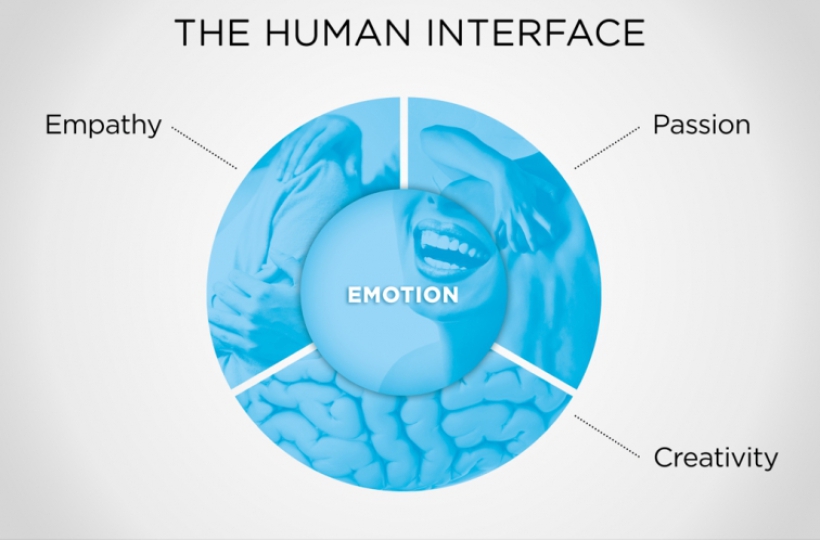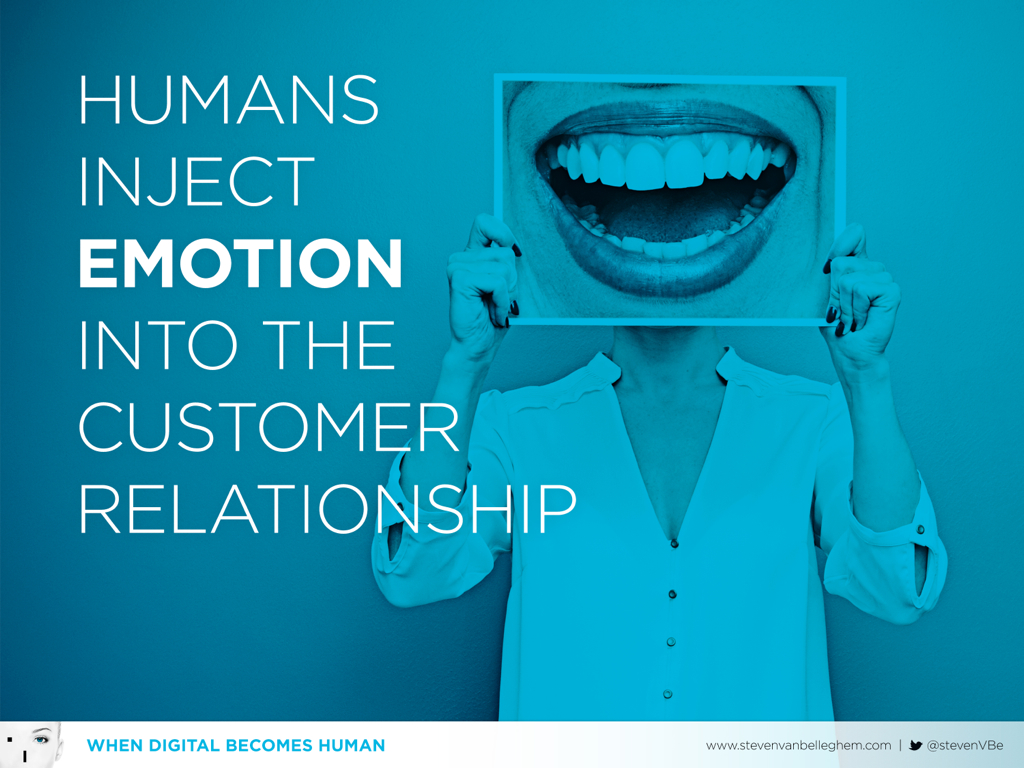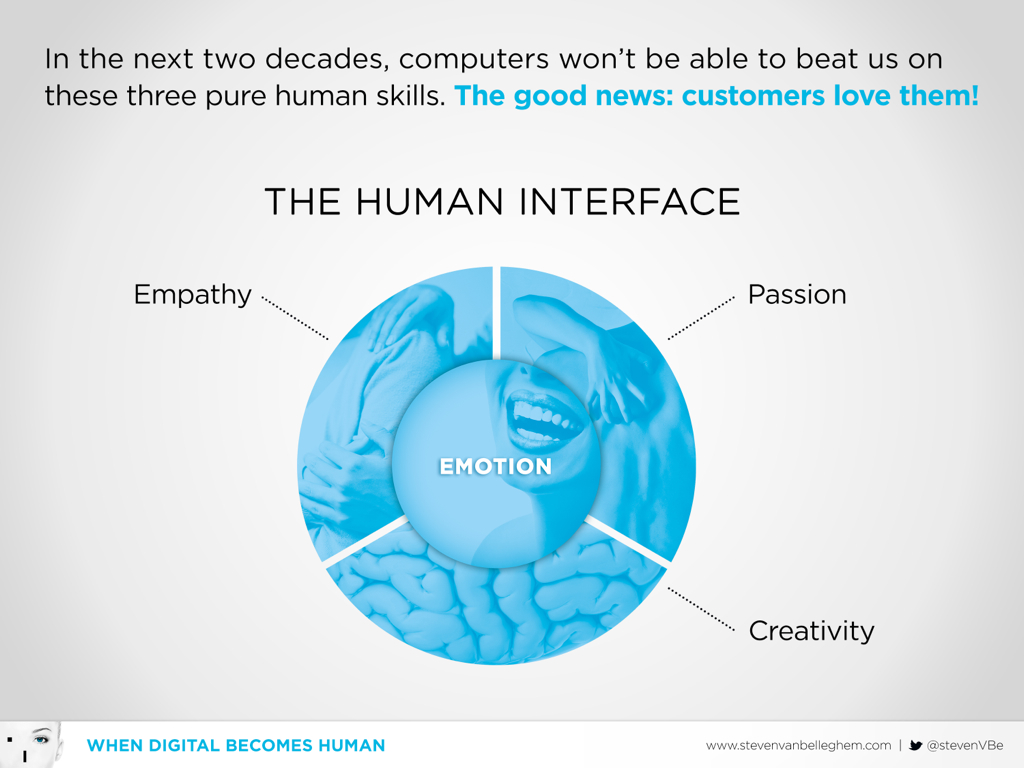Defining the ‘human touch’ in the customer relationship

Of course digitalization will increase dramatically. Of course many jobs will be automated. Even so, I am convinced that in 15 years time it will still be the human touch that makes all the difference in the customer relationship. The problem is that we don’t give this aspect sufficient attention. Because of all the hype around digital transformation, we are focusing too little on the other key strategic question: how can we create added value by using our people to best advantage? This is clearly what today’s consumers want: two out of every three attach great important to a personal touch. Nobody thinks that this is unimportant. 73% still was contact with real people during their dealings with companies, even if the digital channels are working perfectly.
In this short video, I share with you my point of view about ‘defining the human interface’. Hope you enjoy it.
The emotional component of the human interface
In addition to optimizing their digital interface, companies would also be wise to define their human interface. When they do so, it is important to think about the things that computers cannot do. In essence, this can be summarized in a single word: emotion! Computers are good at rational processes. In these matters, the left side of our brain cannot match their power and precision. But the right side of our brain is still light years ahead of the machines in dealing with emotional matters. When it comes to emotion and creativity, humans shine. Companies must use these qualities wisely if they want to develop a balanced, complementary and successful customer relationship; a relationship where the digital and human elements strengthen each other.
Emotion forms the basis of our memories. Certain songs can make us instantly think back to a particular holiday, or our time at university or the first time we were in love. Looking at a photo of a safari immediately calls up the memory of that moment, so that you can almost hear the lion still roaring in your ear. Emotion can also be linked to the experience of products and services. The music played by Disney during their firework shows is pure emotion management. The humor of the Shell petrol attendant described earlier also creates emotion. In his book ‘Brain Rules‘ John Medina describes this process simply. ‘When the brain discovers an emotionally-charged concept, more and more dopamine is released. Dopamine enhances the power of memory, so that these moments remain fixed in our minds.’
The book ‘Emotionomics‘ by Dan Hill clearly proved the financial value of emotions. If companies are able to touch an emotional chord, they will be able to find a place in their customer’s memories. The objective of the human customer relationship is to add emotion to the equation. Adding emotion can have numerous positive effects for a company. It improves financial results, public perception, staff commitment and customer loyalty.
Three areas where computers cannot match humans
The strength of computers lies in the automation of the customer relationship and the added value of the human component is its ability to touch the emotional chord in people. To understand how this human added value is created, it is first necessary to understand what computers cannot do.
To date, computers have not been capable of creating something new. 100% of the world’s innovation has been created by people; 0% by machines. Creativity (1) is therefore the first uniquely human quality that computers cannot match. Nor are computers able to display emotions. My computer is not sad when I am sad – but my family is. My computer is not happy for me when something good happens in my life – but my friends are. Showing empathy (2) is therefore the second uniquely human quality where computers fail. Finally, there is passion (3). People love other passionate people. Passion is infectious and inspirational.
Creativity
In ‘The second machine age‘ the authors emphasize that present-day computers do not possess creativity. They cannot create anything new. Some managers fear that the ‘big data’ hype will limit their own right to be creative. But it is precisely the other way around. Big data needs human creativity before it is capable of giving added value. The data alone is worth very little. It is the way creative people use the data that generates innovation and added value. Without human creativity, the best that data can do is to assist in the optimization of whatever already exists.
Creativity and innovation are uniquely human characteristics. It is smart for companies to allow human creativity to blossom in all phases of the customer relationship. You must allow all your staff to think creatively about improvements that can benefit the customer. Creativity can be applied to the customer relationship on a large scale, but also on a small scale. A window-cleaning company that dresses its operatives in superhero costumes on the day they wash the windows at the local children’s hospital is a brilliantly creative, yet essentially small-scale idea. It costs just a few hundred euros to implement, but has a huge emotional value for all involved. The kids, the hospital and even the window cleaners themselves all love it. Every company should try to make maximum use of the creativity of all its people to achieve this kind of minor improvement in their customer relationship
It is advisable to manage the creativity of a company proactively. When many of the routine processes become automated in the near future, this will have a major impact on the human competencies still necessary in companies. But creative jobs will not be taken over – or not quickly, at least – by robots or computers. Companies will need more creative talent of this kind. And it is important to take the first steps now, by recruiting creative people during the automation phase and by building up a wide network of creative partners. Every company needs creative staff for every element (communication, product development, bookkeeping, sales, etc.) of the customer relationship.
Empathy
Empathy is a basic human quality that a computer has never even heard of. The showing of empathy is a typical human reaction between people. If someone has had bad luck, friends can show sympathy. If someone wins the lottery, friends can join in the celebrations. Empathy can be shown in both positive and negative situations. This is something that my iPhone cannot do, not even the ever-helpful Siri. Neuroscientist Rebecca Saxe is a researcher at the MIT laboratory where studies are being carried out about possible links between the human brain and machines. During her research, she has located the part of the brain that is best suited to assessing other people’s feelings. However, this empathic region is almost impossible to construct in a manner that would make it usable for a computer. It is one of the most complex areas of the brain. To program a computer empathically would require the translation of every emotional concept and feeling into a rational form. This is simply not feasible at present. Even if it was, a computer that is capable of reacting to this new type of programming does not yet exist. The rational parts of our brain are a thousand times easier to duplicate in artificial intelligence than the emotional parts. The sharing of happiness and sadness will not be possible for computers for many years to come.
In a customer relationship, this human characteristic is an extremely powerful element. Being able to empathize with the position of the customer forms the basis for a strong emotional relationship. 92% of customers want the company operatives they deal with to show understanding. Sympathizing with an angry customer can often work wonders. Sympathizing with a distraught customer has impact. Being openly happy for a customer creates a bond. People want to share their emotions, even with the staff of the companies they are dealing with. If someone wants to buy a new car, for them this is a really special day. For the car salesman, it is just another day at work. But the salesman who can contribute to the euphoric feeling of his customer will create a bond – a bond that has a bigger chance of leading to a sale. The salesman who goes about his task in a ‘routine’ manner is more likely to miss out – and will also have less commission at the end of the month.
Passion
Finally, there is passion. Everybody is passionate about something. For some people it is their family. For others, it is their hobby or their career. Nobody is immune. We all have passion. Computers, on the other hand, do not. They simply carry out the tasks they are programmed to complete. People love other passionate people. It doesn’t matter what the story is; if you can tell it passionately, you will have your audience hanging on your every word. A company that has passionate staff of this kind has a major advantage when it comes to creating an emotional bond with customers. Staff who show their pride in their company win the respect of consumers. Enthusiasm of this kind automatically leads to a positive interaction with customers.
Research carried out by LinkedIn in collaboration with Altimeter has shown that company leadership is a key factor in sharing passion with the market. The more passionate a company’s leaders are, the more passionate that company’s staff will also become. Social media are then an ideal place for these enthused staff to share their enthusiasm and pride with the rest of the market. In my book ‘The Conversation Company‘ I devoted considerable attention to the role of company operatives as ambassadors for their companies. This approach has many benefits in helping to find the right human touch. The more staff share their experiences on social media, the more the outside world will be impressed with the passion of the company in question.
Of course, there is much more to sharing passion than simply sharing online stories. Passion is about having a daily dose of drive and motivation. It is about staff who enjoy helping customers. It is about possessing unique human qualities that have an infectious effect on others. The personality and culture of the company forms the basis for all these things. Constantly searching for new ways to transmit this passion to your customers in the online and offline world must become a permanent part of the management of your human-based customer relationship.
The human touch
It gives me a good feeling to think about the role of people in the customer relationship. All too often, people are used routinely, ‘because that’s way we’ve always done it’. Companies need to realize that in future the human element will be one of their scarcest resources in the customer relationship – and therefore one of the most strategically important. People love other people. Using this realization to create an added value for the customer is fun to do and essential for success.

